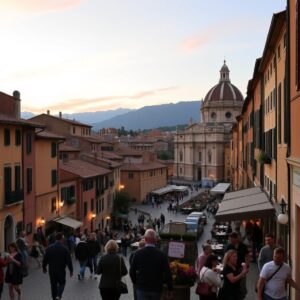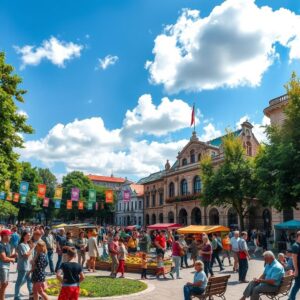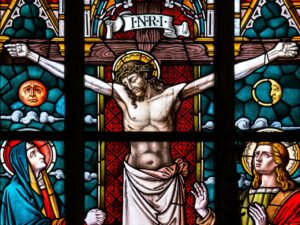
Explore & Play
Discover interesting topics and solve the accompanying crossword puzzle.
Shrine Crossword | Sacred Sites Across the World
Table of Contents
To begin, you can choose to solve the shrine crossword first, or if you’re not yet familiar with the topic, feel free to read through the article to gain more knowledge and then return to the crossword. Either way, this will be a fun and informative way to explore the world of sacred shrines and their significance.
Shrine Crossword
You can either fill in the crossword puzzle directly on this page or click the button in the bottom right corner to print it for free.

Sacred Journeys: The Role of Pilgrimages in Spiritual Life Across Cultures
Pilgrimages have long been a cornerstone of spiritual and religious practices across cultures, guiding believers to sacred sites of profound significance.
What is a Pilgrimage?
A pilgrimage is more than just a journey to a physical destination. It is a profound spiritual quest that involves travel to a site considered holy, aiming to seek blessings, enlightenment, or closeness to the divine. Pilgrimages have been central to various religious traditions, providing a pathway for individuals to deepen their faith, reflect on their lives, and experience personal transformation. From the bustling streets of Vatican City to the serene beauty of Norway’s Nidaros Cathedral, pilgrimage sites worldwide offer both a spiritual retreat and a connection to ancient traditions.
Pilgrimages are often inspired by religious texts, legends, or significant events that occurred at sacred locations. Today, these destinations continue to attract millions of pilgrims, each seeking different forms of solace or spiritual awakening. This article will explore some of the most famous pilgrimage sites around the world, including places featured in our crossword puzzle.
I. The Spiritual Significance of Pilgrimages
At the heart of every pilgrimage lies the deep desire for spiritual growth, transformation, and connection with the divine.
Pilgrimage as a Journey of Faith
For those who embark on pilgrimages, the journey itself is just as important as the destination. The act of walking toward a sacred site serves as both a physical and spiritual exercise, often requiring months of preparation and deep personal commitment. Pilgrims believe that their journey will lead them to a closer relationship with God or to a deeper understanding of themselves.
Pilgrimages can be a way to atone for past mistakes, express gratitude, seek healing, or simply renew one’s faith. As pilgrims move toward their destination, they often undergo a personal transformation that deepens their understanding of their faith and its practices.
How Pilgrimages Shape Religious Practices
Pilgrimages are integral to the religious and cultural practices of many societies. For example, the journey to Santiago de Compostela, one of the most revered Christian pilgrimage sites, has shaped Catholicism’s view on faith, sacrifice, and devotion. Pilgrims to Mount Athos, an ancient Greek site of monasticism, contribute to the preservation of Orthodox Christian traditions, while Buddhist pilgrims make pilgrimages to places like the Shwedagon Pagoda, where they strengthen their connection with the teachings of the Buddha.
In each of these traditions, the pilgrimage is not just a physical journey; it is a spiritual practice that revitalizes faith and reinforces the bonds within a religious community.
II. Famous Pilgrimage Sites Across the World
Some pilgrimage sites are renowned for their spiritual importance, drawing millions of pilgrims from around the world each year.
Christian Pilgrimages
St. Peter’s Basilica (Vatican)
Located at the heart of the Catholic Church, St. Peter’s Basilica is not only a masterpiece of Renaissance architecture but also a central site for Catholic pilgrimage. Pilgrims flock to this sacred site to seek divine guidance, pay homage to St. Peter, and experience a connection to the Holy See. The basilica’s grandeur and religious significance make it a pivotal destination for millions of visitors each year.
Santiago de Compostela
The Camino de Santiago, or Way of St. James, is one of the most famous pilgrimage routes in the Christian world. This ancient path leads pilgrims across Spain to the Cathedral of Santiago de Compostela, where it is believed that the apostle St. James is buried. Pilgrims often walk the route to seek spiritual growth and fulfill promises made to the saints.
Fatima and Lourdes
Both Fatima in Portugal and Lourdes in France are known for their miraculous associations. Fatima is particularly famous for the apparitions of the Virgin Mary in 1917, which led to its establishment as a key site for Catholic pilgrims. Lourdes, on the other hand, attracts millions due to the healing waters of its spring, which many believe hold miraculous properties.
Nidaros Cathedral (Norway)
In Norway, Nidaros Cathedral is a key pilgrimage site, particularly for those following the St. Olav’s Way. This Gothic masterpiece, built over the burial site of Saint Olav, draws thousands of pilgrims every year. For Norwegian Christians, Nidaros represents the heart of their faith, combining religious devotion with national identity.
Walsingham (UK)
Walsingham, often referred to as the “Nazareth of the North,” has been a pilgrimage site since the 11th century. The shrine of Our Lady of Walsingham attracts pilgrims from all over the world who seek to honor the Virgin Mary. Pilgrims here often participate in processions and prayer services, following in the footsteps of generations of faithful believers.
Orthodox Pilgrimage Sites
Mount Athos (Greece)
Mount Athos is a monastic republic and one of the most important pilgrimage sites for Orthodox Christians. With its hundreds of monasteries and a strict no-women policy, it remains a powerful symbol of Orthodox monastic life. Pilgrims who visit Mount Athos seek spiritual guidance and enlightenment in its peaceful and secluded atmosphere.
St. Mark’s (Venice)
Another important site for Orthodox Christians, St. Mark’s Basilica in Venice stands as a beacon of Byzantine art and architecture. Pilgrims from across the world visit to pay homage to the apostle St. Mark, whose relics are kept within the basilica.
Buddhist Pilgrimages
Tooth Temple (Sri Lanka)
The Tooth Temple in Kandy, Sri Lanka, houses the sacred tooth relic of the Buddha. It is a key site for Buddhists worldwide, and the pilgrimage to this temple is a journey to honor the Buddha’s teachings and the relic itself.
Shwedagon Pagoda (Myanmar)
The Shwedagon Pagoda in Myanmar is one of the most important Buddhist pilgrimage sites. It is said to house relics of four Buddhas, making it a place of great spiritual significance. Pilgrims travel to this golden structure to pay their respects and seek spiritual enlightenment.
III. Pilgrimages in Norway: A Unique Sacred Landscape
Norway’s rich religious history and serene natural landscapes make it an exceptional destination for pilgrims seeking divine peace and connection.
Nidaros Cathedral (Trondheim)
Nidaros Cathedral in Trondheim, Norway, stands as a testament to the country’s deep Christian roots. The cathedral is not only a place of worship but also a symbol of the nation’s religious identity. Pilgrims who visit this site are often walking in the footsteps of Saint Olav, whose remains are interred there.
St. Olav’s Way
St. Olav’s Way is a historic pilgrimage route that leads to Nidaros Cathedral. The route, which stretches across Norway, was used by medieval pilgrims traveling to honor Saint Olav. Today, it continues to draw individuals seeking spiritual solace and a deeper connection with Norway’s Christian history.
St. Therese Shrine
The St. Therese Shrine, located in Norway, is a place for pilgrimage and prayer dedicated to Saint Therese of Lisieux. It attracts individuals who seek healing and spiritual guidance, offering a serene and peaceful environment for reflection.
Heddal Stave Church
Heddal Stave Church is Norway’s largest and most famous wooden church. Although not as widely known as Nidaros, it still draws visitors for its remarkable architecture and peaceful ambiance. The church serves as a quiet space for both local worship and pilgrimage.
IV. Pilgrimage Routes in Europe: Historical Paths and Modern Journeys
Europe is home to some of the oldest and most historically significant pilgrimage routes that still attract modern-day pilgrims.
The Camino de Santiago
The Camino de Santiago, stretching across Spain and parts of France, is arguably the most famous pilgrimage route in Europe. The path, which leads to the Cathedral of Santiago de Compostela, is filled with historical landmarks and spiritual significance, making it a must-visit for any devout pilgrim.
The Via Francigena
This ancient pilgrimage route runs from Canterbury in England to Rome in Italy, passing through a range of cultural landscapes. For centuries, it has been traveled by pilgrims seeking spiritual solace and a deeper connection with the Vatican. Today, the Via Francigena is still used by many as a route to fulfill their pilgrimage.
St. Olav’s Way
St. Olav’s Way is not only significant in Norway but is part of a larger network of pilgrimage routes in Europe. It represents the connection between Scandinavian and European religious traditions, drawing individuals seeking spiritual renewal from across the continent.
V. Pilgrimages in Asia: Sacred Journeys Across the East
In Asia, pilgrimage sites are steeped in ancient traditions and carry deep spiritual significance across multiple faiths.
Mount Kailash
Mount Kailash, located in Tibet, is one of the most revered pilgrimage sites in the world. Sacred to Hindus, Buddhists, and Jains, the mountain is believed to be the abode of Lord Shiva. Pilgrims trek around the mountain in a journey that symbolizes both physical endurance and spiritual purification.
The Golden Pavilion
The Golden Pavilion in Kyoto, Japan, is a sacred Zen Buddhist temple that attracts pilgrims seeking spiritual tranquility. Its serene setting and stunning architecture make it one of the most popular pilgrimage destinations in Japan.
Shwedagon Pagoda
The Shwedagon Pagoda, already mentioned in the Buddhist pilgrimages section, continues to serve as one of the holiest places for Buddhists, drawing thousands of pilgrims who come to pay their respects and offer prayers.
VI. The Architecture of Sacred Sites: Faith in Form
Beyond their spiritual significance, the shrines and sanctuaries visited by pilgrims also stand as architectural wonders that reflect the divine in their design.
St. Peter’s Basilica
The awe-inspiring St. Peter’s Basilica in Vatican City is not just a place of worship but also a masterpiece of Renaissance architecture. Designed by some of the most renowned architects, it is a reflection of the Catholic Church’s wealth, power, and deep-rooted faith.
Nidaros Cathedral
Nidaros Cathedral is a blend of Gothic and Romanesque architectural styles. Its towering spires, intricate stone carvings, and colorful stained glass windows provide an impressive setting for both pilgrims and tourists alike.
Mount Athos Monasteries
The monasteries of Mount Athos are a marvel of Byzantine architecture. Set against the backdrop of rugged mountains, their design is both functional and symbolic, embodying the spiritual devotion of Orthodox Christians.
VII. The Personal Impact of Pilgrimages
For many pilgrims, the impact of their journey goes beyond religious rituals; it serves as a transformative experience that shapes their identity.
Transformative Experiences
Many pilgrims report experiencing life-changing moments during their travels. The act of walking for miles toward a sacred destination can serve as both a physical and metaphorical journey. It’s an opportunity for self-reflection, personal growth, and the resolution of inner conflict.
Pilgrims often come away from these journeys with a renewed sense of purpose, an altered perspective on life, and an intensified connection to their faith. These transformative experiences not only affect the individuals themselves but can also deeply impact their communities, spreading a renewed sense of spiritual vitality.
Conclusion: The Eternal Call to Pilgrimage
Pilgrimages, whether ancient or modern, continue to offer an enduring path to spiritual growth, peace, and reflection for millions of people worldwide.
Share to...
I hope you enjoy the content.
Want to receive our daily crossword puzzle or article? Subscribe!
You may also be interested in
Share to…
Want to receive our daily crossword puzzle?
-
Jigsaw Puzzles
Chinese Dragon Jigsaw Puzzle – Zodiac Series Art 250 | 300 | 500 Pieces
kr 348,00 – kr 439,00Price range: kr 348,00 through kr 439,00 Select options This product has multiple variants. The options may be chosen on the product page -
Jigsaw Puzzles
Charming Hamster Art Nouveau Jigsaw Puzzle 250 | 300 | 500 Pieces
kr 348,00 – kr 439,00Price range: kr 348,00 through kr 439,00 Select options This product has multiple variants. The options may be chosen on the product page -
Jigsaw Puzzles
Oslo Opera House Abstract Jigsaw Puzzle 250 | 300 | 500 Pieces
kr 348,00 – kr 439,00Price range: kr 348,00 through kr 439,00 Select options This product has multiple variants. The options may be chosen on the product page

















